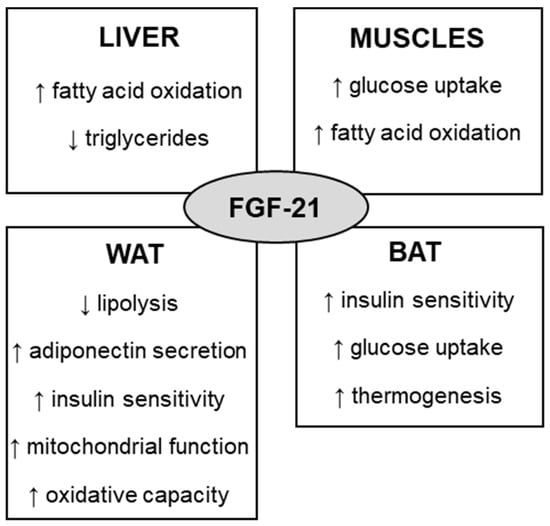Fibroblast growth factor 21 (FGF-21) is a protein that is involved in the regulation of glucose, lipids, and energy metabolism. To act on target tissues, endocrine FGF-21 binds preferably to FGF receptor 1 (FGFR1) in the presence of the coreceptor named β-klotho (KLB). Some of the effects of FGF-21 include increased fatty acid oxidation, glucose uptake, insulin sensitivity, and thermogenesis, which can regulate body weight and glycemia control. By exerting such metabolic effects, the therapeutic potential of FGF-21 for the treatment of obesity and diabetes has been investigated. Physical exercise has been widely used for the prevention and treatment of obesity. Several mechanisms mediate the effects of physical exercise, including the FGF-21 pathway. Studies have shown that physical exercise increases the concentration of circulating and tissue FGF-21 in animals, while contradictory results are still observed in humans.
- FGF-21
- physical exercise
- obesity
1. Introduction
2. FGF-21 Metabolic Effects
FGF is a large protein family, with 22 members in mammals. Based on gene sequence homology and phylogeny, the FGF family can be divided into seven subfamilies, among which the endocrine FGF-19 subfamily consists of three FGFs, namely FGF-19 (FGF-15 in rodents), FGF-21, and FGF-23 [14][17]. In order to act on target tissues, FGF-21 binds to FGF receptor 1 (FGFR1) in the presence of the transmembrane protein named β-klotho [15][16][18,19]. FGF-21 can also act by other receptors, such as FGFR2, FGFR3, and FGFR4, however it prefers to bind to FGFR1 over these other receptors [17][20]. Kharitonenkov et al. (2005) were the first to describe FGF-21 as a possible metabolic regulator [5]. They observed that transgenic mice expressing human FGF-21 submitted to high-fat diet for 15 weeks were resistant to obesity, and presented lower levels of fasting glucose and leptin. They also showed that FGF-21 indirectly exerts hypoglycemic effects by inhibiting glucagon secretion. Other studies have reported beneficial effects of FGF-21, including reduction in body weight, liver and circulating triglycerides, fasting plasma insulin and glucose, and increase in energy expenditure [3][18][3,21]. Interestingly, obesity and type 2 diabetes have also been associated with increased circulating FGF-21 concentration in humans [19][22] and animals [20][23]. The paradoxical effect of FGF-21 was first explained by the FGF-21 resistance associated with lower expression of KLB and FGFR1 [21][24], but this was contradicted in a recent review by [22][25]. FGF-21 exerts metabolic effects on several tissues (Figure 1). In the liver, FGF21 stimulates fatty acid oxidation and reduces lipid flux by increasing peripheral lipoprotein catabolism and reducing adipocyte lipolysis [23][26]. In the white adipose tissue (WAT), it suppresses lipolysis and enhances insulin sensitivity and adiponectin secretion [23][24][26,27], thus ameliorating some harmful effects of obesity, such as hyperglycemia, glucose intolerance, insulin resistance, and dyslipidemia [25][26][28,29]. In the brown adipose tissue (BAT), FGF-21 increases glucose uptake, lipolysis, and thermogenesis [27][30]. Other tissue actions of the FGF-21 can be found in the review published by She et al. (2022) [14][17].
3. Effect of Physical Exercise on FGF-21
Physical exercise acts in different ways in the body, as it can alter protein secretion, influencing circulating but also locally levels. A continuous aerobic exercise session increases the circulating FGF-21 in both lean and obese individuals immediately after exercise for up to one hour [28][40]. Interestingly, a high-intensity interval training (HIIT) session appears to prolong the increased levels of FGF-21 induced by the exercise up to 3 h after the end of the session in lean men, while this effect can last for up to 48 h when the resistance exercise with seven types of exercises targeting all the main muscle groups was performed [29][41]. In obese people submitted to acute moderate-intensity exercise (treadmill exercise, ∼60% peak oxygen uptake), circulating concentrations of FGF21 were elevated after exercise for up to 6 h [30][42]. Based on research, it seems that resistance exercise session is the type of exercise that keeps the FGF-21 level higher for longer post-acute exercise. It is important to point out that the acute exercise effect on FGF-21 is not a consensus in the literature. Cuevas-Ramos et al. (2012) [31][43] and Parmar et al. (2018) [32][44] observed no significant changes in serum FGF21 of lean individuals after a single session of aerobic exercise and resistance exercise, respectively. A summary of the effects of physical exercise on circulating FGF-21 in lean and obese individuals is demonstrated in the Figure 2. It appears that the intensity of the aerobic exercise affects the FGF-21 secretion response. In fact, He et al. (2019) [33][45] that showed a higher serum concentration of FGF-21 after performing exercise at 90% of maximum heart rate (HR max) in comparison to an exercise performed at 69% of HR max. Furthermore, the correlation between exercise volume and the levels of FGF-21 remains unclear and it is suggested that endogenous FGF-21 is associated with the magnitude of caloric expenditure and oxidative stress caused by acute strenuous physical exercise [34][46]. This gap remains, and further studies are needed to confirm this hypothesis.
